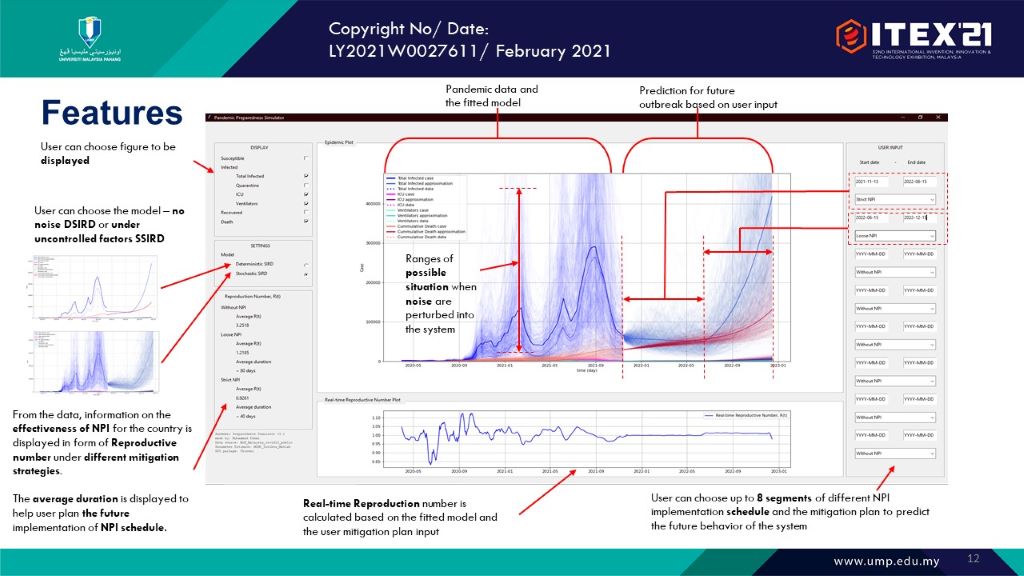Associate Professor Dr. Norhayati designs simulator for COVID-19 pandemic stochastic modelling
Associate Professor Dr. Norhayati designs simulator for COVID-19 pandemic stochastic modelling

PEKAN, 8 June 2022 – The COVID-19 pandemic recorded a sharp increase in the use of intensive care unit (ICU) beds and equipment in hospitals around the world and particulalry in the Ministry of Health Malaysia (MOH).
Based on this situation, the lecturer of the Centre for Mathematical Sciences (PSM), Universiti Malaysia Pahang (UMP), Associate Professor Dr. Norhayati Rosli, designed the Pandemic Preparedness Simulation Tool so that the country can prepare for the possible public health facilities inadequacy due to the pandemic especially the use of beds and equipment in the ICU.
According to her, it is a vital matter that requires forecasting based on the interventions carried out and the people’s adherence to the government’s standard operating procedures (SOPs).
“The research, which started in 2020 and is expected to be fully completed in 2022, is the outcome of the collaboration with the Director of the Centre of Excellence in Artificial Intelligence and Data Science, Dr. Noryanti Muhammad and PSM doctoral student, Muhammad Fahmi Ahmad Zuber.
“This research is related to COVID-19 pandemic modelling using stochastic models to predict active cases of COVID-19 patients across three categories, namely patients with mild symptoms, symptoms requiring ventilators and symptoms requiring ventilators and being treated in the ICU.
“The pandemic modelling considers the stochastic factor (environmental noise) which is the implementation and adherence to non-pharmaceutical interventions (NPI) enforced to curb the spread of the pandemic,” she said.
She said the stochastic modelling has been changed into a graphical user interface (GUI) to be used by the agencies involved in forecasting the COVID-19 pandemic or outbreak with similar characteristics without understanding the concept of stochastic modelling.
“Users can choose the type of stochastic model if the stochastic factors, for example, the implementation and compliance with the enforced NPI, are to be considered, or the deterministic model if without random factors.
“Users can enter the input of the NPI implementation period and the NPI category whether it is strict NPI, loose NPI or without NPI.
“When the user runs the simulator and GUI, it will display a forecast for the active number of infected patients, quarantined patients (positive with mild symptoms), patients treated in a hospital or quarantine centre (positive and requiring monitoring or assistance of breathing apparatus), patients who need treatment in the ICU and ventilator assistance, the number of patients cured, and die based on time,” she said.
She hoped that this research would help the country deal with infectious diseases such as COVID-19.
She further explained that this model could be modified according to the characteristics of other infectious diseases.
“In fact, it can also be adopted by the industry for the forecasting of active cases in the industry based on time so that the industry can prepare for any potential sharp increase in cases.
“This research also received the cooperation of external agencies namely the Pahang State Health Department and the Crisis Preparedness and Response Centre (CPRC), Hospital Tengku Ampuan Afzan (HTAA), Kuantan,” she said.
A meeting with the Pahang State Health Department and CPRC, HTAA was held on 26 January 2021 to promote technology for the community and see the potential to highlight this research.
She also developed the Graphical User Interface of the Monte Carlo Simulation for the Transportation of Ammonia in Industry in collaboration with Petronas Chemicals Ammonia Sdn. Bhd.
The estimated cost for this research is RM35,000.00.
The research also won a gold medal in the Creation, Innovation, Technology & Research Exposition (CITREx) 2021.
At the International Invention, Innovation and Technology Exhibition (ITEX) 2021, held at Kuala Lumpur Convention Centre from 13 to 14 December 2021, this research bagged a silver medal.


